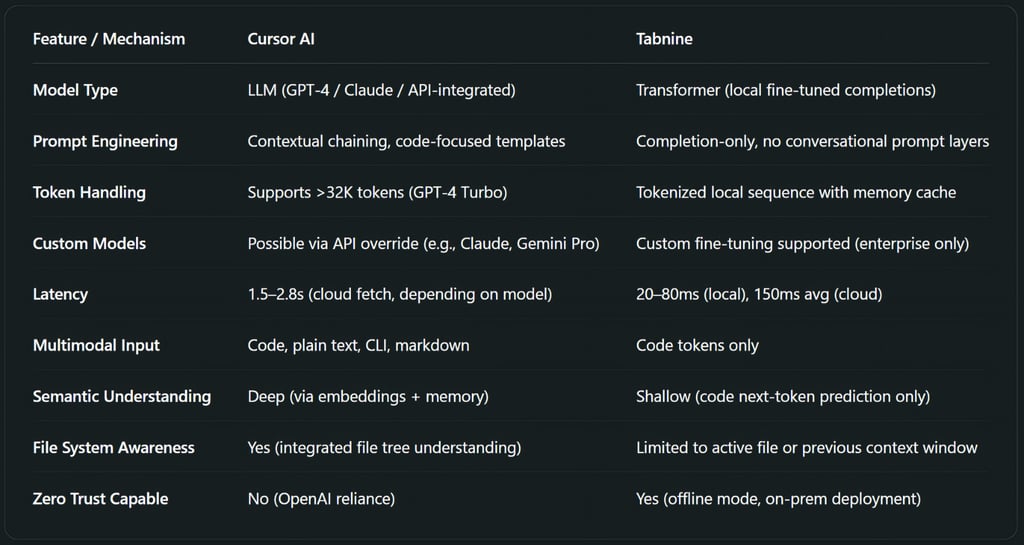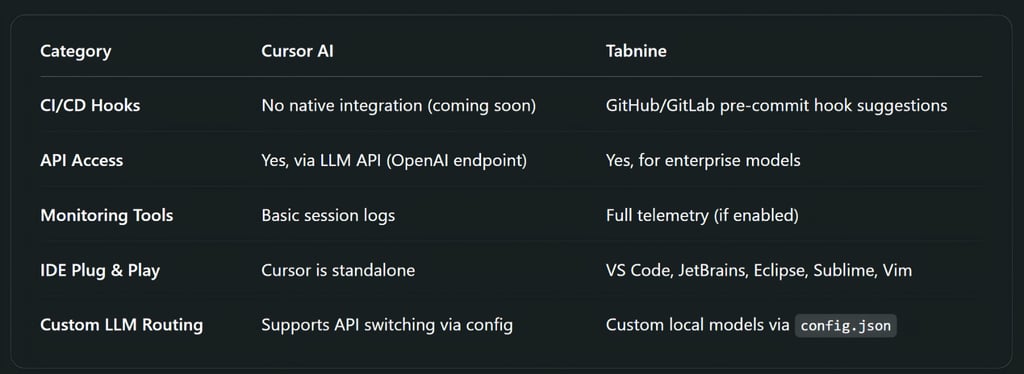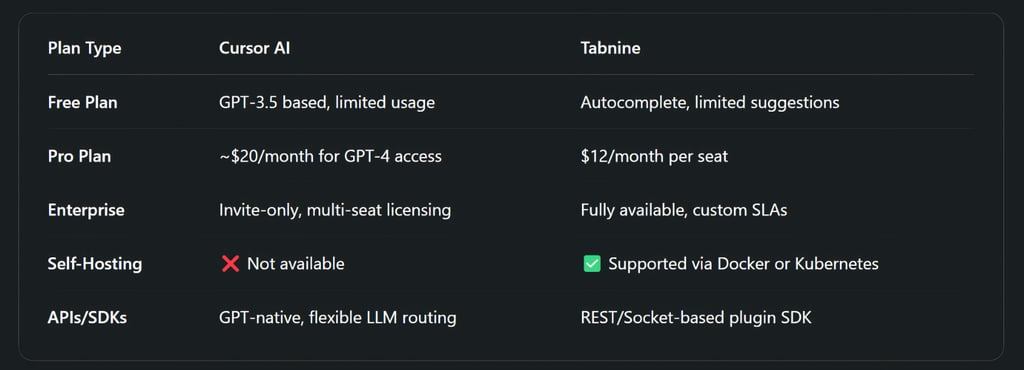
The Future of Coding: Cursor AI vs Tabnine Deep Dive for Developers
Explore the detailed comparison between Cursor AI and Tabnine, two leading AI-powered coding assistants in 2025. Discover their architecture, advanced features, security, deployment options, and performance benchmarks to help you choose the best AI assistant for your development environment.
AI ASSISTANTPROGRAMMINGAI/FUTUREEDUCATION/KNOWLEDGE
Sachin K Chaurasiya
4/18/20254 min read


The rise of AI-native developer tools has introduced a new wave of productivity, creativity, and automation in software engineering. At the forefront of this revolution are Cursor AI and Tabnine — both leveraging AI to assist, but through distinctly different paradigms.
In this extended guide, we go beyond surface-level features and explore architecture, LLM integration, code intelligence, deployment, and developer ergonomics. Whether you’re a CTO, an ML engineer, or a dev looking to supercharge your IDE, this article is for you.
Cursor AI
Cursor AI is a modern, AI-powered code editor built entirely around GPT-4 technology. Unlike traditional tools that offer AI as a plugin, Cursor is designed as a dedicated AI-first environment, making it more immersive and intelligent in understanding your codebase.
Key Features
Full editor built on VS Code, offering familiarity with AI enhancements.
Deep refactoring capabilities and real-time debugging assistance.
Integrated chat-style interaction with the AI for better problem-solving.
High context awareness, understanding even large codebases efficiently.
Multi-language support including Python, JavaScript, TypeScript, Rust, and more.
Standout Features
Full IDE experience with AI-native interface.
Conversational coding via an embedded chatbot in the editor.
Refactor, explain, or debug code in seconds.
Real-time understanding of the entire codebase, including multiple files, folders, and dependencies.
One-click test generation, documentation, and code transformation.
Intelligent error explanations, especially for bugs that stump even experienced devs.
Use Cases
Want an AI that can explain, fix, and optimize code in real time?
Frequently work on complex, multi-file codebases.
Are you open to a new workflow focused on chat-based collaboration?
Prefer an integrated AI development environment rather than just completion.
Tech Stack Compatibility
JavaScript/TypeScript
Python
Go
Rust
Java
C/C++
HTML/CSS
Model Architecture & AI Integration
Backed by GPT-4/GPT-4 Turbo, with optional Claude or custom LLMs via API integration.
Uses document embeddings + vector-based search to enable multi-file code comprehension.
Employs in-editor memory layers to maintain stateful context during multi-turn conversations.
Auto-chunking of code files enables LLMs to analyze larger-than-token-limit inputs.
Uses AST (Abstract Syntax Tree) transformations to refactor code semantically, not just syntactically.
Example Workflow
You highlight 5 files → Ask, “Refactor these into cleaner modules using React hooks.” → Cursor parses the AST → Sends it to GPT-4 Turbo with semantic token optimization → Rewrites + highlights changes with inline diff view.


Tabnine
Tabnine, on the other hand, is a well-established AI code completion tool that seamlessly integrates with existing IDEs. It’s lightweight, fast, and focused on enhancing productivity through real-time suggestions — not replacing your workflow, but enriching it.
Key Features
Works with VS Code, JetBrains, Sublime Text, and other popular IDEs.
Offers inline code suggestions as you type.
Local model options for teams concerned about privacy and security.
Supports dozens of programming languages.
Team training capabilities for customized AI suggestions.
Noteworthy Features
Predictive code completion using deep learning models.
Offline capabilities via locally hosted models.
Custom model training on your codebase for team consistency.
Minimal interference — perfect for developers who don’t want to change workflows.
High-speed inline suggestions that learn from your previous code patterns.
Use Cases
Prefer to keep your current IDE but want smarter code suggestions.
Work in enterprise or offline environments where data control matters.
Need a privacy-focused AI assistant for team-level use.
Want something lightweight and fast without a learning curve.
Enterprise-Friendly
Tabnine Enterprise offers on-premises deployment and zero cloud dependencies, ensuring code privacy, compliance, and IP security.
Model Architecture & AI Integration
Built using deep-learning models trained on permissively licensed open-source code (vs. GPT’s general corpus).
Tabnine’s local inference engine is based on quantized transformer variants fine-tuned for token efficiency.
Offers self-hosted model deployment with GPU acceleration (CUDA/NVIDIA) or CPU-only inference.
The enterprise version supports vector index embedding to match private code snippets and suggest completions.
Tabnine Advanced Use Case
Self-hosted Docker container running Tabnine Engine → Developer IDE connects locally via REST API → Tabnine scans repo and trains embeddings per project → Serves fast completions in under 50ms per token on average.








Security and Privacy: Engineering Insights
Cursor AI
Relies on OpenAI-hosted LLMs.
Data is temporarily cached during sessions and anonymized, but cannot be self-hosted.
Limited control over outbound data — risky for air-gapped or compliance-heavy teams (e.g., HIPAA, FedRAMP).
Planned: API proxy layer to sanitize inputs before LLM calls.
Tabnine
Offers complete air-gapped installation via on-premise GPU servers or local Docker runtime.
Zero network dependency — all model inference and training is localized.
Supports custom data retention policies, SSO, audit trails, and GDPR-ready logs.
Developer Experience: Code Ergonomics Breakdown
Cursor AI
Excellent for exploratory programming — just ask, “What’s wrong with this regex?” and it explains, debugs, and rewrites.
Full codebase understanding reduces friction during cross-module refactors.
Markdown + Docs generation in natural language (e.g., generate JSDoc or README scaffolding).
Tabnine
Superb for boilerplate-heavy codebases (e.g., Java Spring, .NET MVC).
Faster than Cursor for inline completions, especially in existing workflows.
Best used alongside GitHub Copilot or GPT-based tools for more creative logic.
Which Is Technically Superior?
Cursor AI is technically ahead in semantic reasoning, LLM orchestration, and natural interaction, but it’s cloud-dependent and less ideal for secure, high-regulation environments.
Tabnine, though not as “intelligent,” wins in predictability, performance, privacy, and deployment flexibility, especially for enterprise software teams and DevSecOps pipelines.
Would You Like These Too?
✅ TL;DR social media post version
✅ Export to Markdown, HTML, or Word format
✅ Comparison image chart for visual sharing
✅ Optimized blog headline & meta description
Subscribe To Our Newsletter
All © Copyright reserved by Accessible-Learning Hub
| Terms & Conditions
Knowledge is power. Learn with Us. 📚


